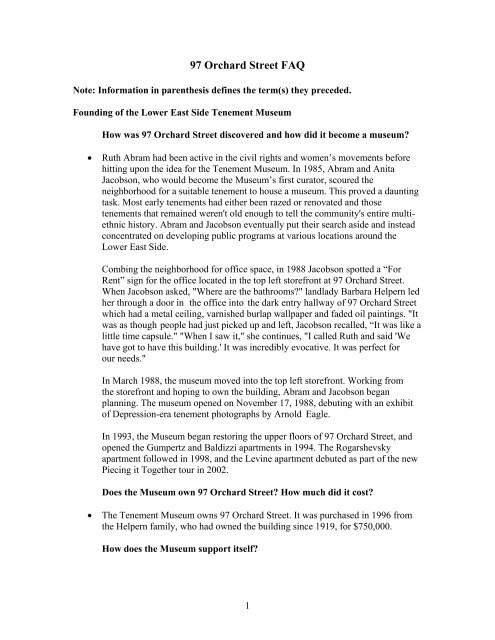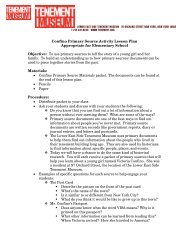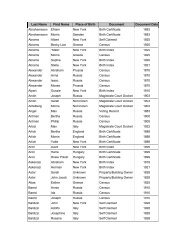97 Orchard Street FAQ - Lower East Side Tenement Museum
97 Orchard Street FAQ - Lower East Side Tenement Museum
97 Orchard Street FAQ - Lower East Side Tenement Museum
- No tags were found...
Create successful ePaper yourself
Turn your PDF publications into a flip-book with our unique Google optimized e-Paper software.
<strong>97</strong> <strong>Orchard</strong> <strong>Street</strong> <strong>FAQ</strong>Note: Information in parenthesis defines the term(s) they preceded.Founding of the <strong>Lower</strong> <strong>East</strong> <strong>Side</strong> <strong>Tenement</strong> <strong>Museum</strong>How was <strong>97</strong> <strong>Orchard</strong> <strong>Street</strong> discovered and how did it become a museum?• Ruth Abram had been active in the civil rights and women’s movements beforehitting upon the idea for the <strong>Tenement</strong> <strong>Museum</strong>. In 1985, Abram and AnitaJacobson, who would become the <strong>Museum</strong>’s first curator, scoured theneighborhood for a suitable tenement to house a museum. This proved a dauntingtask. Most early tenements had either been razed or renovated and thosetenements that remained weren't old enough to tell the community's entire multiethnichistory. Abram and Jacobson eventually put their search aside and insteadconcentrated on developing public programs at various locations around the<strong>Lower</strong> <strong>East</strong> <strong>Side</strong>.Combing the neighborhood for office space, in 1988 Jacobson spotted a “ForRent” sign for the office located in the top left storefront at <strong>97</strong> <strong>Orchard</strong> <strong>Street</strong>.When Jacobson asked, "Where are the bathrooms?" landlady Barbara Helpern ledher through a door in the office into the dark entry hallway of <strong>97</strong> <strong>Orchard</strong> <strong>Street</strong>which had a metal ceiling, varnished burlap wallpaper and faded oil paintings. "Itwas as though people had just picked up and left, Jacobson recalled, “It was like alittle time capsule." "When I saw it," she continues, "I called Ruth and said 'Wehave got to have this building.' It was incredibly evocative. It was perfect forour needs."In March 1988, the museum moved into the top left storefront. Working fromthe storefront and hoping to own the building, Abram and Jacobson beganplanning. The museum opened on November 17, 1988, debuting with an exhibitof Depression-era tenement photographs by Arnold Eagle.In 1993, the <strong>Museum</strong> began restoring the upper floors of <strong>97</strong> <strong>Orchard</strong> <strong>Street</strong>, andopened the Gumpertz and Baldizzi apartments in 1994. The Rogarshevskyapartment followed in 1998, and the Levine apartment debuted as part of the newPiecing it Together tour in 2002.Does the <strong>Museum</strong> own <strong>97</strong> <strong>Orchard</strong> <strong>Street</strong>? How much did it cost?• The <strong>Tenement</strong> <strong>Museum</strong> owns <strong>97</strong> <strong>Orchard</strong> <strong>Street</strong>. It was purchased in 1996 fromthe Helpern family, who had owned the building since 1919, for $750,000.How does the <strong>Museum</strong> support itself?1
• The <strong>Museum</strong> supports itself through a combination of fundraising and earnedincome. Funding obtained from corporate and union grants, foundation grants,government grants, individual contributions and memberships, and special eventscomprise more than half of the <strong>Museum</strong>’s financial support. Earned income fromshop sales, admissions for public tours and groups, the theatre program, shootsand space rental for parties, International Coalition revenues, and rental incomecomprise the remainder.<strong>97</strong> <strong>Orchard</strong> <strong>Street</strong>Was <strong>97</strong> <strong>Orchard</strong> <strong>Street</strong> the first tenement to be built on the block?• By 1828, there were structures on all thirteen lots on the western side of <strong>Orchard</strong><strong>Street</strong> between Broome and Delancey. Except for the church and the building onthe corner of Broome <strong>Street</strong>, which was probably a multifamily residence with astore on the ground floor, all were mainly residential. For the most part, thesewere two-to-three story wood frame dwellings which, by the 1850s were beingused as multifamily residences. Initial development of the <strong>97</strong> <strong>Orchard</strong> <strong>Street</strong> lotbegan with the erection of a Reformed Dutch Church in 1828, which stood onwhat is today 95, <strong>97</strong>, and 99 <strong>Orchard</strong> <strong>Street</strong>. In 1860, the Dutch Reformedcongregation sold the church to a Universalist congregation who not long aftersold it again to the Second Reformed Presbyterian Church. Three years later, in1863, the property was purchased by Lukas Glockner, Adam Strum, and JacobWalter. The new owners demolished the church structure, for the 1864 <strong>Orchard</strong><strong>Street</strong> tax rolls list three new five-story tenements on the lots, one belonging toeach of the buyers. As only one-fifth of the buildings located in the 10 th wardwere tenements, 95, <strong>97</strong>, and 99 <strong>Orchard</strong> <strong>Street</strong>s are the earliest survivingtenements on the block bounded by Broome and Delancey.How did <strong>97</strong> <strong>Orchard</strong> <strong>Street</strong> end up situated on a smaller than typical lot?• The typical Manhattan lot size of 25 x 100 was mandated by the 1811Commissioners plan for the City of New York. On the <strong>Lower</strong> <strong>East</strong> <strong>Side</strong>, streetsextending as far north as Houston (then North) <strong>Street</strong> were laid out in 1804, priorto the Commissioners plan, resulting in lot sizes of varying measurements,including the 25x 88 lot on which <strong>97</strong> <strong>Orchard</strong> <strong>Street</strong> now stands.What is the architectural detail on the façade, archways, and cornices of thebuildings?• The front façade of <strong>97</strong> <strong>Orchard</strong> <strong>Street</strong> is an extremely simple version of theItalianate style, the most popular style for buildings erected in New York Cityduring the early 1860s. By the time <strong>97</strong> <strong>Orchard</strong> <strong>Street</strong> was built, the Italianatestyle, featuring arched openings for doors and windows, projecting stone lintels (asupporting wood or stone beam across the top of an opening, such as that of awindow or door or fireplace), and foliate brackets (decorated with carved leaves),2
had filtered down to even the most modest projects. At <strong>97</strong> <strong>Orchard</strong> <strong>Street</strong>, thebrick façade of the upper floors is ornamented by segmental-arch windowopenings (the circular arch above each window in which the inner circle is lessthan a semicircle) with brownstone trim. An Italianate projecting-metal cornicecaps the façade and is coated with brownstone-colored sand paint.Upon what is the reproduction of the stoop based?• <strong>97</strong> <strong>Orchard</strong> <strong>Street</strong>’s stoop and wooden façade was restored in 2001 to look as itdid circa 1905 when then landlords Barnet Goldfein and Benjamin Posner gavethe stoop and storefronts a facelift. Using a circa 1915 photo of the Rogarshevskyfamily taken in front of <strong>97</strong> <strong>Orchard</strong> <strong>Street</strong>, architects Li/Saltzman traced andcompared elements in the image with extant examples in the vicinity toresponsibly restore the stoop and façade.Were there always fire escapes on the building? Did they look like the fireescapes we see today?• As required by the 1862 law that established the Department of Buildings, an ironfire escape was originally attached to the front of <strong>97</strong> <strong>Orchard</strong> <strong>Street</strong>. An earlyexample of fire escape design, it is known as a fire ladder. Instead of the stairwaysfound on most New York fire escapes, the example at <strong>97</strong> <strong>Orchard</strong> St. employed avertical ladder. It was removed in the late 1<strong>97</strong>0s or early 1980s. The <strong>Museum</strong>replaced the fire escape in 19<strong>97</strong>, with a replica that mimics the original design ofthe landing barriers, but uses stairs instead of ladders. The use of fire ladders isprohibited by the Fire Department, but landlords with original fire ladders are notrequired to replace them.Was there only a fire escape on the front of the building in the 1860s?• In 1863 there was a fire escape serving the south apartments and a party balconyserving the north apartments on the rear of <strong>97</strong> <strong>Orchard</strong> <strong>Street</strong> These partybalconies connected the north apartment of each floor with its neighbor at 99<strong>Orchard</strong> <strong>Street</strong>. In case of a fire at <strong>97</strong> <strong>Orchard</strong> <strong>Street</strong>, the residents were supposedto climb onto the balcony and escape by entering the apartment in the adjacentbuilding. While the party balconies are extant, the south fire escape was removedand replaced with the fire tower that remains today.What were some of the retail businesses that that operated out of <strong>97</strong> <strong>Orchard</strong><strong>Street</strong> through the years?• Other than Schneider’s Saloon, we know few details about the shops at <strong>97</strong><strong>Orchard</strong> <strong>Street</strong> during the 19 th century. During the 20 th century, some of the shopsincluded the Auction Exchange of Herman and Marcus Brandies, the <strong>Orchard</strong>Printing Company, Fischer and Schimmel Hosiery, the Seaboard Importing Co.,Felty’s Hats, and the stove and range repair shop of Morris and Irving Claman.3
When was Schneider’s Saloon in operation and which storefront did itoccupy?• Schneider’s Saloon was in operation at <strong>97</strong> <strong>Orchard</strong> St. from 1865 to 1886. We arenot yet sure whether the saloon occupied the basement-level left or rightstorefront.How does the <strong>Museum</strong> know when specific structural changes occurred inthe building?• The <strong>Museum</strong> gained knowledge of specific structural changes that occurred in thebuilding from New York City Department of Buildings records (such as permitsfor repairs and alterations), paint analyses, and building analyses conducted byprofessional architects.What do we know about the wallpaper in <strong>97</strong> <strong>Orchard</strong> <strong>Street</strong>?• Around 1905, the main hall on the first floor was redesigned with the addition ofan inexpensive, but durable covering of burlap painted red, and later shellackedwith a brown varnish. In the late 1880s, wallpaper began to replace paint on thefront room walls of apartments in <strong>97</strong> <strong>Orchard</strong> <strong>Street</strong>. We believe the landlordarranged for the walls to be papered probably every time new tenants moved intoan apartment. Landlords may have opted to use wallpaper instead of paint becausewith its busy patterns, it better hid imperfections in the walls. In some casestenants apparently added wallpaper in order to beautify the room.In some of the apartments at <strong>97</strong> <strong>Orchard</strong> <strong>Street</strong>, up to 22 layers of wallpaper werediscovered by paper conservator Reba Fishman Snyder. 7-10 layers of paint werefound underneath the wallpaper in the front rooms. The walls of the kitchensand bedrooms exhibit an average of 37 to 39 layers of paint. Because thebuilding was occupied for 72 years (from 1864 through 1935), simple statisticalanalysis shows that the interior surfaces were painted approximately every twoyears.A textile and wallpaper company called Scalamandre reproduced the wallpapersin the Gumpertz, Rogarshevsky, and Levine apartments pro bono for the<strong>Tenement</strong> <strong>Museum</strong>. The papers are available for sale by Scalamandre.When were the metal ceilings installed, what are they made from, and whydid the landlord chose to put them up?• The ceilings in the hallways throughout <strong>97</strong> <strong>Orchard</strong> <strong>Street</strong> are covered in pressedmetal, made from an alloy of steel and iron. These ceilings were installed circa1900. Metal ceilings were popular because they were easier to maintain thaneasily damaged plaster. Different patterns are visible in the halls of <strong>97</strong> <strong>Orchard</strong>4
<strong>Street</strong>, since sections were often patched with a piece of metal that did not matchthe original.What did the privies at <strong>97</strong> <strong>Orchard</strong> <strong>Street</strong> look like?• When Lucas Glockner constructed <strong>97</strong> <strong>Orchard</strong> <strong>Street</strong> he provided toilet facilitiesthat, however primitive by today’s standards, were more advanced than requiredby law. Glockner constructed a privy vault or an outdoor group of toilets with acommon waste compartment that was connected to a sewer. It had a mechanismthat permitted someone to regularly flush out the vault. Such vaults were laterreferred to as school sinks, so named because of their popularity at public schools.During excavation of the privies in 1993, the <strong>Museum</strong>’s archaeologist discoveredin the northwestern corner of the yard what she believes are three toiletcompartments, each measuring about 2’-6’’ wide by 3’-9’’ deep, at <strong>97</strong> <strong>Orchard</strong><strong>Street</strong>. These appear to have shared a wall with the privies at 99 <strong>Orchard</strong> <strong>Street</strong>,aligned in two abutting rows of three running along the northern lot line betweennos. <strong>97</strong> and 99. Each compartment had a wood seat and a door with some sort ofslit or hole for light and ventilation.During the 1860s, how many privies were required by law?• The 1867 <strong>Tenement</strong> House Act required that one toilet or privy be provided forevery 20 people, and that privies be connected to sewers where these wereavailable.How old are the toilets in <strong>97</strong> <strong>Orchard</strong> <strong>Street</strong>?• According to the Real Estate Record and Guide, which contains a list ofalterations made to buildings in 1905, the toilets and adjacent airshaft wereinstalled in 1905.Was there a law that was passed during the time that <strong>97</strong> <strong>Orchard</strong> <strong>Street</strong> wasopen to residents which required the installation of one toilet for eachapartment?• There was no law passed during the time that <strong>97</strong> <strong>Orchard</strong> <strong>Street</strong> was open toresidents which required the installation of a toilet in each apartment. While the1929 Multiple Dwellings law mandated the installation of one toilet in eachapartment for all newly constructed buildings, neither the 1929 MultipleDwellings Laws, nor the 1930 or 1934 amendments to the law, required the toiletsin the apartments of older tenements.Where did residents get their water?• By the 1860s, water delivered from upstate New York by the Croton Aqueducthad become widely available in New York City. We believe water from a5
ackyard hydrant or spigot was available to the residents of <strong>97</strong> <strong>Orchard</strong> <strong>Street</strong>when the building opened in 1864. There tenants filled buckets and basins,hauling the heavy receptacles to their apartments.When was gas lighting introduced into the building?• Gas lighting was introduced into the building sometime between 1896 and 1905,possibly to conform to the 1901 <strong>Tenement</strong> House Act which required landlords tohave a lamp burning from sunset to sunrise near the stair on the entrance and thesecond floor. A cap on a gas pressure reduction device on the first floor isinscribed “Property of the American Gas Reduction Company, NY”; this firmentered business in 1896. Each tenant would have paid for gas individually andeach apartment would have had a coin-operated meter that had to be fed in orderto turn on the gas.When was electricity introduced into the building?• Electricity was introduced into <strong>97</strong> <strong>Orchard</strong> <strong>Street</strong> at some point after 1918, thepatent date on the electrical panels located at the rear of the hall on the first floor.One former resident remembers that electricity was added in 1924, the year heentered kindergarten.When and why were the fireplaces boarded up in the parlors?• We believe all of the fireplaces in the parlors of <strong>97</strong> <strong>Orchard</strong> <strong>Street</strong> were sealed bythe late 1880s. These alterations were completed at different times and in differentways—in some cases the openings were simply boarded up, in others the existingmantels were removed and used as a baseboard, and the entire wall replastered.With a stove operating more or less simultaneously in the kitchen of the smallapartments, it is unlikely that an additional heat source was really needed, and thedrafts produced from the chimneys may have been counterproductive to attemptsto heat the rooms.It is evident from the ceiling in the Gumpertz apartment that the wall wasmoved between the parlor and the kitchen. When did this happen and why?• During the 19 th century, the most dramatic change to the apartments at <strong>97</strong> <strong>Orchard</strong><strong>Street</strong> was the enlargement of the kitchens. Circa 1895, the wall between thekitchen and the parlor was moved two feet four inches into the parlor. This costlyalteration appears to have occurred in conjunction with the addition interiorwindows between the kitchen and parlor, cupboards in the kitchens, and water inthe apartments.As a result of the 1901 Law, did the landlords have to reconstruct thesouthern side of the building in order to create an air shaft?6
• In compliance with the 1901 <strong>Tenement</strong> House Act, landlords Barnet Goldfein andBenjamin Posner commissioned architect Otto Reissmann to alter <strong>97</strong> <strong>Orchard</strong> in1905. Improvements at that time included the construction of a fireproof airshafton the south side of the building with two adjoining water closets on each floor.The loss of space in affected apartments required that partitions between kitchensand bedrooms be moved.Are the closets in each apartment original?• The wood closets located in the front room of each apartment are original featuresthat date to 1864. Circa 1895-96, the closets were moved when the wall betweenthe parlor and kitchen were shifted in order to accommodate the installation ofplumbing and soapstone tub sinks. In 1887, New York State passed a lawmandating the installation of water into the apartments erected after May 14, 1867and permitting the New York City Health Department to order the installation ofwater in older tenements such as <strong>97</strong> <strong>Orchard</strong> <strong>Street</strong>. The owner of <strong>97</strong> <strong>Orchard</strong><strong>Street</strong> probably did not actually install the water system until after 1895 when theNew York State Court of Appeals upheld the legality of the 1887 law which hadbeen challenged by Trinity Church, owner of a great deal of land occupied by oldand substandard tenements and converted rowhouses.Who provided the stoves in each apartment?• The wood- or coal-burning cast-iron stoves used by residents of <strong>97</strong> <strong>Orchard</strong> <strong>Street</strong>to cook and heat their homes was generally the property of the tenant and not thelandlord. The residents themselves would have been responsible for carrying thestoves upstairs to their respective apartments. The heavy, cumbersome stoves,however, are comprised of interlocking pieces that can be disassembled for easytransport and later put back together.Were there ever any fires at <strong>97</strong> <strong>Orchard</strong> <strong>Street</strong>?• Documents indicate that the Fire Department responded to at least 7 fires at <strong>97</strong><strong>Orchard</strong> <strong>Street</strong> between 1863 and 1935—one in 1863, two in 1899, two in 1901,one in 1909, and one in 1934. These records give no indication that the firescaused any more than insignificant damage.How many landlords owned <strong>97</strong> <strong>Orchard</strong> <strong>Street</strong>? Did any besides LucasGlockner live in the building?• Approximately fifteen landlords owned <strong>97</strong> <strong>Orchard</strong> <strong>Street</strong> between 1863 and1994. Like the residents of <strong>97</strong> <strong>Orchard</strong> <strong>Street</strong>, the building’s owners wereimmigrants and most worked in the garment industry before getting involved inreal estate. These landlords tended to be mobile, moving from home to home,buying property and quickly selling it. Only four landlords owned <strong>97</strong> <strong>Orchard</strong><strong>Street</strong> for more than five years. The landlords of <strong>97</strong> <strong>Orchard</strong> <strong>Street</strong> were usually7
tenement dwellers themselves. Sometimes they lived in <strong>East</strong> Harlem or Yorkvilletenements, but they were just as likely to live in a tenement apartment around thecorner from <strong>97</strong> <strong>Orchard</strong> <strong>Street</strong>. With the exception of Lucas Glockner, it seemsthat none of the other owners lived at <strong>97</strong> <strong>Orchard</strong> <strong>Street</strong>.How was it that <strong>97</strong> <strong>Orchard</strong> <strong>Street</strong> was left untouched for over fifty yearsafter the building was shut down as a place of residence?• The closure and resultant vacancy of <strong>97</strong> <strong>Orchard</strong> <strong>Street</strong> may have been the resultof the difficulty of renting apartments in older tenements on the <strong>Lower</strong> <strong>East</strong> <strong>Side</strong>,coupled with the demands of a law passed in 1934 that would have required theremoval of all wood in the public halls, including the replacement of the entirewood staircase with metal of some other incombustible material. In addition, thepassage of restrictive immigration laws in 1924 almost completely ended the flowof new residents to the <strong>Lower</strong> <strong>East</strong> <strong>Side</strong>. This was coupled with the fact that asolder immigrants prospered, they moved out of the <strong>Lower</strong> <strong>East</strong> <strong>Side</strong> to lessdensely populated neighborhoods, especially in Brooklyn and the Bronx, that hadnewer buildings of higher quality. Indeed, between 1920 and 1930, theneighborhood’s population declined by 40%.Behind the ScenesHow do we choose the families and themes explored in each apartment?• The <strong>Museum</strong> selects particular family stories that are substantially documented byhistorical records, to demonstrate the building’s ethnic and religious diversity, thechronological span of its habitation and, most importantly, their ability to raisepressing and sometimes controversial contemporary issues.How many descendants of <strong>97</strong> <strong>Orchard</strong> <strong>Street</strong> has the <strong>Museum</strong> contacted?• The <strong>Tenement</strong> <strong>Museum</strong> has been able to contact over 200 descendants of former<strong>97</strong> <strong>Orchard</strong> <strong>Street</strong> residents.What are some of the objects that were discovered in the apartments?• Over 2,000 objects were discovered in the apartments include a pillow, atoothbrush, earrings, hairpins, dishes, shoes, and books, among others. Some ofthe objects found at <strong>97</strong> <strong>Orchard</strong> <strong>Street</strong> are displayed in the ruin apartment on thethird floor.What objects were actually owned by former residents of <strong>97</strong> <strong>Orchard</strong> <strong>Street</strong>?• Confino Apartment:1. Manta, a bright red blanket that looks like a shag carpet, on metal bed was8
donated by Solomon Confino, a cousin of Victoria’s, who also lived at <strong>97</strong><strong>Orchard</strong> <strong>Street</strong>.Baldizzi Apartment:1. Linit starch box – on back of sink2. Cloth napkins– on kitchen table3. Baking pan – grey enameled, in sink4. Bedspread – folded on chair in front room (blue)5. Dish towels – monogrammed, hanging on string over sink6. Vaporizer – in north cabinet7. Table runners (2) – in suitcase and adjacent crate in front room8. Colander – on kitchen counterRogarshevsky Apartment1. White enamel bucket underneath the laundry tub in kitchen2. Egg beaters hanging from the back room window in kitchen9














